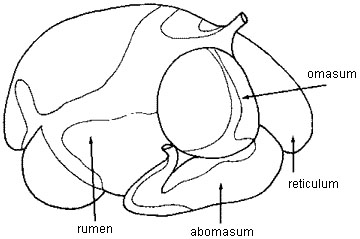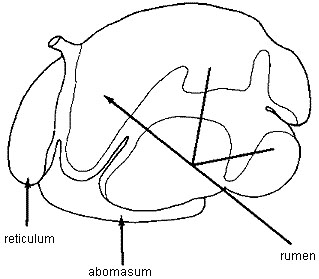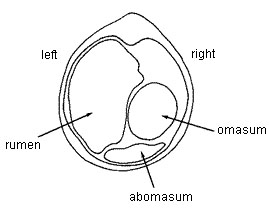The abomasum is the fourth, or "true," stomach in the cow. It normally lies low down in the right front quadrant of the abdomen, just inside the seventh through 11th ribs (Figure 1). Adjacent to the abomasum, on the left side of the abdomen, is the large first stomach, or rumen (Figure 2).
 Figure 1a
Figure 1a
Normal bovine stomach, right view.
 Figure 1b
Figure 1b
Normal location of abomasum.
 Figure 2
Figure 2
Bovine. Divisions of stomach, left view.
The abomasum occasionally may be displaced to the left of the rumen and upwards when its muscular wall loses tone and the stomach becomes filled with gas. This condition is left abomasal displacement (Figure 3).
 Figure 3a
Figure 3a
Normal position of abomasum on right side.
 Figure 3b
Figure 3b
Abomasum displaced to the left of rumen.
In another displacement, the abomasum rides up high on the right side underneath the last ribs and again is enlarged with gas and some fluid. Sometimes the right displaced abomasum turns into a much more serious and often fatal abomasal torsion.
In either left or right abomasal displacement, the entrance and exit to the stomach are slightly kinked. The kinks, together with the gas and fluid distension, slow food passage to a slower-than-normal rate. The signs seen in the cow are usually dullness; a marked drop in feed intake, especially of concentrates; a drastic reduction in milk yield; and scanty feces either firm or diarrheic. Most left displacements occur within one month after calving. Heavy yielding and older dairy cows are usually affected. Right displacements are spread out more throughout the three months after calving.
Cause
Abomasal displacement is seen almost exclusively in dairy breeds. Several theories attempt to explain the condition, but no definite single cause is known. Heavy concentrate and low roughage feeding programs produce an enlarged abomasum while rumen size decreases. Such diets in late pregnancy may play a role in producing the condition. Heavy grain feeding and sudden changes in levels of grain feeding are often suspected.
Incidence of abomasal displacements has increased tremendously in the last two decades, a period of rapidly improving management and feeding practices. This condition seems to be a bad side-effect of otherwise good animal husbandry practices.
Diagnosis
The veterinarian diagnoses displacement of the abomasum by compiling an accurate history of the animal, assessing clinical signs and listening with a stethoscope to the abdominal sounds. Abnormal sounds are produced when the abomasum becomes trapped high up on the left or right side and enlarged with gas.
The veterinarian must rule out several other conditions that cause obstruction of the gut before he or she can make an accurate diagnosis. Sometimes the veterinarian must surgically enter the abdomen to arrive at the diagnosis.
Many times, hauling the animal in a truck produces sufficient movement of the abdominal organs to partially correct the condition. The stockman may bring an affected cow to the veterinarian only to find that she is normal upon arrival at the veterinary hospital. In these instances, however, the condition usually recurs in a few days.
Treatment
Treatment requires replacing the abomasum in its normal position. Preferably, the veterinarian also prevents recurrence by tacking the abomasum to the body wall.
Often the cow gets temporary relief if she is cast on her right side and then rolled onto her back, permitting the abomasum to "float" back into its normal position. In nearly all such cases, however, the problem recurs within a few days. Permanent correction is best achieved by surgically entering the abdomen, emptying the gas, replacing the abomasum and suturing it down to the body wall.
The results of surgery are usually excellent. Complications are seen if the diagnosis is made several weeks after the displacement occurs. During that time, body condition is lost and abomasal ulcers may develop and sometimes perforate to produce a peritonitis.
Prevention
To prevent the development of displaced abomasum, ensure that calculated total crude fiber in the ration exceeds 17 percent. Make all feed changes near calving time slowly, especially any increase in grain or other concentrates. Give cows plenty of time to reach peak production. Encourage exercise.
Any case of ketosis in a newly calved cow could be a possible abomasal displacement. Seek veterinary help if you suspect a problem.